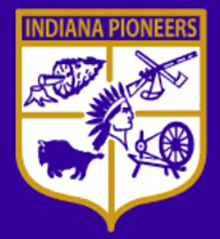Saturdays, noon to 1 p.m. ET on WICR 88.7 FM.
Or stream audio live from anywhere on WICR Online!
January 22, 2022
Hook’s and Haag: drug stores once iconic in Indiana

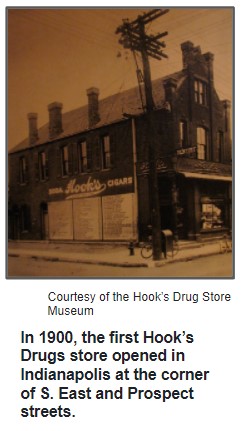 Does it seem like a CVS or a Walgreen’s can be found on every street corner? In Indiana for much of the 1900s, the drug store scene was much different, and dominated by two locally-owned rivals.
Does it seem like a CVS or a Walgreen’s can be found on every street corner? In Indiana for much of the 1900s, the drug store scene was much different, and dominated by two locally-owned rivals.
Hook’s Drug Stores opened its first store in 1900 in Indianapolis in what’s now the Bates-Hendricks neighborhood, then considered part of Fountain Square. Haag Drug began even earlier, with the opening of a pharmacy in 1876 on Massachusetts Avenue in downtown Indy.
The captivating history of these competitors, which included Hook’s becoming the country’s 12th largest drugstore chain, and the two brothers who founded Haag being accused of bootlegging during Prohibition will be the focus of our show. Although both the Haag and Hook’s names had vanished from retailing by the mid-1990s, the legacy of the latter is celebrated at the Hook’s Drug Store Museum at the Indiana State Fairgrounds.
Nelson’s guest will be Indianapolis civic leader David Steele, a board member of the museum. David has crusaded for a historic marker that will be dedicated later this year on the site of the first Hook’s store at South East and Prospect streets.
Hooks and Haag were so successful that by 1982, Hook’s had 267 stores across Indiana Both dabbled in side businesses, including restaurant chains. Huddle Restaurants, the chain affiliated with Haag, was particularly popular, with dining spots that were open 24 hours per day in Bloomington, Kokomo, Terre Haute, Fort Wayne and other cities in addition to the Indy metro area. Knife & Fork, the chain affiliated with Hook’s, was much smaller and shorter-lived.
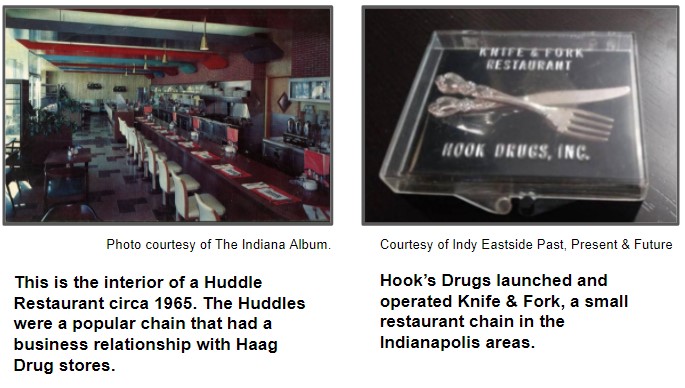
By then, though, the Haag brothers had been charged with bootlegging and spent time in prison. During Prohibition, bottles of whiskey, brandy, vermouth and other alcohol – ingredients in some of the tonics and potions sold at their pharmacies – were found on their shelves. For a while, their nephew oversaw the drug stores, which eventually were sold to various Indiana businessmen, including descendants of the famous Ball Brothers of Muncie.
John Hook became a civic leader, encouraging his pharmacists to volunteer at local hospitals that lacked full-time pharmacists. Subsequent owners of the Hook’s chain were commended for promoting minorities into management positions.
The Hook’s Drug Store Museum opened during the Indiana State Fair in 1966 with the intent of being a temporary exhibit. But the museum, a recreation of an Indiana drug store at the dawn of the 20th century, remains on its original site.
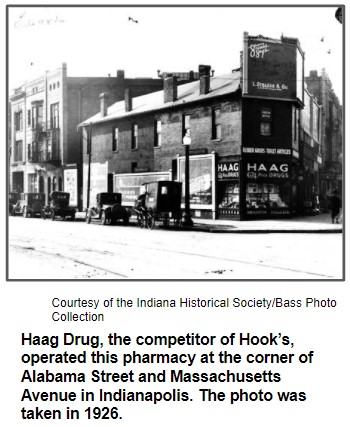 Haag pharmacies became known for their expanded product lines, which eventually included cameras, perfumes, toys and children’s clothes during eras when those items typically were not found at drug stores. Many of the Haag stores were attached to Huddle restaurants, which enabled customers to flow between the two without stepping outdoors.
Haag pharmacies became known for their expanded product lines, which eventually included cameras, perfumes, toys and children’s clothes during eras when those items typically were not found at drug stores. Many of the Haag stores were attached to Huddle restaurants, which enabled customers to flow between the two without stepping outdoors.
By 1980, Haag had been purchased by People’s Drugs, which later became part of CVS. At Hook’s, a series of company buyouts during the 1980s and ‘90s involved Kroger and Revco Drug Company. Revco then was acquired by CVS.
Our guest David Steele grew up near the first Hook’s store on the near-southeast side of Indy. David was a Hoosier History Live guest in 2020 for a show about the state’s musical instrument-making heritage; his boyhood neighborhood also was the site, during the 1920s, of the world’s largest drum factory.
Roadtrip: Scotland Bridge near Kirklin
Guest Roadtripper Janet Gilray of Noblesville tells us that “Scotland Bridge doesn’t really look like that much,” but it’s a rare remaining stone arch bridge less than an hour’s drive northwest of Indianapolis. It’s also known as Boone County Bridge #41, and is located at 9463 North 200 East in Boone County, crossing Sugar Creek. (By the way, there is more than one Sugar Creek in Indiana.) The bridge was built 1901 and rebuilt in 1908, and is a 120-foot-long, three-span bridge built of Indiana limestone.
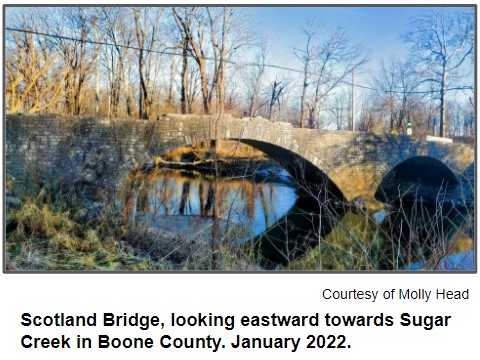
From the Hoosier History archives
Hoosier History Live looks back . . .
Did you miss the show "Rev. Martin Luther King's visits to Indiana"
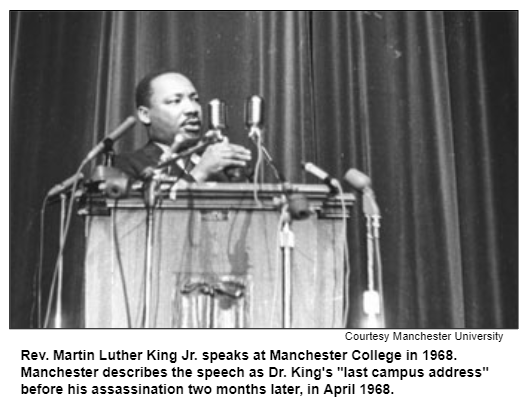
Both before he became a household name nationally, and after he was a famous public figure, Rev. Martin Luther King Jr. made trips to Indiana. How those visits during the 1950s and '60s unfolded, where Rev. King stayed and other details, was the focus of the Hoosier History Live show which aired live on January 19, 2019.
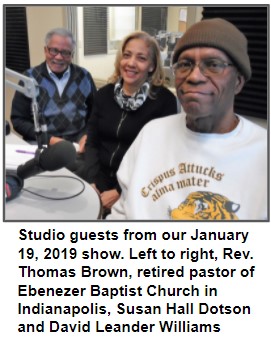 Our guests that day were Rev. Thomas Brown, retired pastor of Ebenezer Baptist Church in Indianapolis, Susan Hall Dotson, African American Collections Curator at the Indiana Historical Society, and David Leander Williams, author and an adjunct professor at IUPUI.
Our guests that day were Rev. Thomas Brown, retired pastor of Ebenezer Baptist Church in Indianapolis, Susan Hall Dotson, African American Collections Curator at the Indiana Historical Society, and David Leander Williams, author and an adjunct professor at IUPUI.
Click here to listen to the show podcast.
Hoosier History Live’s African American History podcast collection is under development and is available for sponsorship.
Nelson Price, host and historian
Molly Head, producer/general manager, (317) 506-7164
Ryan DeRome, associate producer
Cheryl Lamb, administrative manager
Richard Sullivan, senior tech consultant
Pam Fraizer, graphic designer
Garry Chilluffo, consultant
Please tell our sponsors that you appreciate their support!

 Acknowledgments to WICR-FM, Fraizer Designs, The Indiana Album, Monomedia, Indiana Historical Bureau, Indiana Landmarks, Henri Pensis, Kielynn Talley, Genesis Brown, Heather McIntyre, and many other individuals and organizations. We are independently produced and are self-supporting through organizational sponsorship and through individual contribution at the yellow button on our newsletter or website. For organizational sponsorship, which includes logos, links, and voiced credits in the show, contact Molly Head at (317) 506-7164 or email her at molly@hoosierhistorylive.org. Our media reach continues to grow via podcasting.
Acknowledgments to WICR-FM, Fraizer Designs, The Indiana Album, Monomedia, Indiana Historical Bureau, Indiana Landmarks, Henri Pensis, Kielynn Talley, Genesis Brown, Heather McIntyre, and many other individuals and organizations. We are independently produced and are self-supporting through organizational sponsorship and through individual contribution at the yellow button on our newsletter or website. For organizational sponsorship, which includes logos, links, and voiced credits in the show, contact Molly Head at (317) 506-7164 or email her at molly@hoosierhistorylive.org. Our media reach continues to grow via podcasting.
Thank you!
We'd like to thank the following recent individual contributors who make this show possible. For a full list of contributors over the years, visit Support the Show on our website.
- Dr. James Madison
- Dr. William McNiece
- Michael Freeland and Sharon Butsch Freeland
© 2022 Hoosier History Live. All rights reserved.
|


